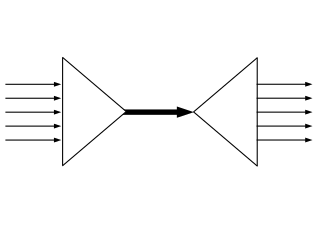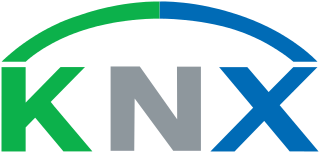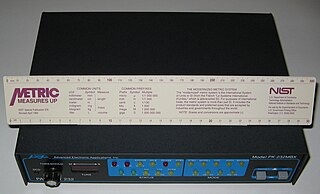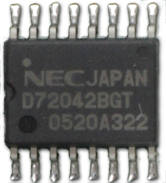
In computer architecture, a bus is a communication system that transfers data between components inside a computer, or between computers. This expression covers all related hardware components and software, including communication protocols.

In the context of an operating system, a device driver is a computer program that operates or controls a particular type of device that is attached to a computer or automaton. A driver provides a software interface to hardware devices, enabling operating systems and other computer programs to access hardware functions without needing to know precise details about the hardware being used.

In telecommunications, RS-232 or Recommended Standard 232 is a standard originally introduced in 1960 for serial communication transmission of data. It formally defines signals connecting between a DTE such as a computer terminal or PC, and a DCE, such as a modem. The standard defines the electrical characteristics and timing of signals, the meaning of signals, and the physical size and pinout of connectors. The current version of the standard is TIA-232-F Interface Between Data Terminal Equipment and Data Circuit-Terminating Equipment Employing Serial Binary Data Interchange, issued in 1997.

X10 is a protocol for communication among electronic devices used for home automation (domotics). It primarily uses power line wiring for signaling and control, where the signals involve brief radio frequency bursts representing digital information. A wireless radio-based protocol transport is also defined.

An embedded system is a specialized computer system—a combination of a computer processor, computer memory, and input/output peripheral devices—that has a dedicated function within a larger mechanical or electronic system. It is embedded as part of a complete device often including electrical or electronic hardware and mechanical parts. Because an embedded system typically controls physical operations of the machine that it is embedded within, it often has real-time computing constraints. Embedded systems control many devices in common use. In 2009, it was estimated that ninety-eight percent of all microprocessors manufactured were used in embedded systems.

A universal asynchronous receiver-transmitter is a peripheral device for asynchronous serial communication in which the data format and transmission speeds are configurable. It sends data bits one by one, from the least significant to the most significant, framed by start and stop bits so that precise timing is handled by the communication channel. The electric signaling levels are handled by a driver circuit external to the UART. Common signal levels are RS-232, RS-485, and raw TTL for short debugging links. Early teletypewriters used current loops.

A serial port is a serial communication interface through which information transfers in or out sequentially one bit at a time. This is in contrast to a parallel port, which communicates multiple bits simultaneously in parallel. Throughout most of the history of personal computers, data has been transferred through serial ports to devices such as modems, terminals, various peripherals, and directly between computers.

Software-defined radio (SDR) is a radio communication system where components that conventionally have been implemented in analog hardware are instead implemented by means of software on a computer or embedded system. While the concept of SDR is not new, the rapidly evolving capabilities of digital electronics render practical many processes which were once only theoretically possible.
Loopback is the routing of electronic signals or digital data streams back to their source without intentional processing or modification. It is primarily a means of testing the communications infrastructure.

KNX is an open standard for commercial and residential building automation. KNX devices can manage lighting, blinds and shutters, HVAC, security systems, energy management, audio video, domestic appliances, displays, remote control, etc. KNX evolved from three earlier standards; the European Home Systems Protocol (EHS), BatiBUS, and the European Installation Bus.

Electronic test equipment is used to create signals and capture responses from electronic devices under test (DUTs). In this way, the proper operation of the DUT can be proven or faults in the device can be traced. Use of electronic test equipment is essential to any serious work on electronics systems.
Serial Peripheral Interface (SPI) is a de facto standard for synchronous serial communication, used primarily in embedded systems for short-distance wired communication between integrated circuits.

A mobile data terminal (MDT) or mobile digital computer (MDC) is a computerized device used in emergency services, public transport, taxicabs, package delivery, roadside assistance, and logistics, among other fields, to communicate with a central dispatcher. They are also used to display mapping and information relevant to the tasks and actions performed by the vehicle such as CAD drawings, diagrams and safety information.

A terminal node controller (TNC) is a device used by amateur radio operators to participate in AX.25 packet radio networks. It is similar in function to the Packet Assembler/Disassemblers used on X.25 networks, with the addition of a modem to convert baseband digital signals to audio tones.
RS-485, also known as TIA-485(-A) or EIA-485, is a standard, originally introduced in 1983, defining the electrical characteristics of drivers and receivers for use in serial communications systems. Electrical signaling is balanced, and multipoint systems are supported. The standard is jointly published by the Telecommunications Industry Association and Electronic Industries Alliance (TIA/EIA). Digital communications networks implementing the standard can be used effectively over long distances and in electrically noisy environments. Multiple receivers may be connected to such a network in a linear, multidrop bus. These characteristics make RS-485 useful in industrial control systems and similar applications.

A universal synchronous and asynchronous receiver-transmitter is a type of a serial interface device that can be programmed to communicate asynchronously or synchronously. See universal asynchronous receiver-transmitter (UART) for a discussion of the asynchronous capabilities of these devices.
The sport of amateur radio contesting has been responsible for the development of contesting technology specific to the sport. The most competitive stations participating in contests employ new and innovative technology, hardware, and software. Some of these innovations are exclusively used in the sport of contesting; others have seen wider application in amateur radio at large.
D-STAR is a digital voice and data protocol specification for amateur radio. The system was developed in the late 1990s by the Japan Amateur Radio League and uses minimum-shift keying in its packet-based standard. There are other digital modes that have been adapted for use by amateurs, but D-STAR was the first that was designed specifically for amateur radio.

IEBus is a communication bus specification "between equipments within a vehicle or a chassis" of Renesas Electronics. It defines OSI model layer 1 and layer 2 specification. IEBus is mainly used for car audio and car navigations, which established de facto standard in Japan, though SAE J1850 is major in United States.
IEBus is also used in some vending machines, which major customer is Fuji Electric. Each button on the vending machine has an IEBus ID, i.e. has a controller.
Detailed specification is disclosed to licensees only, but protocol analyzers are provided from some test equipment vendors. Its modulation method is PWM with 6.00 MHz base clock originally, but most of automotive customers use 6.291 MHz, and physical layer is a pair of differential signalling harness. Its physical layer adopts half-duplex, asynchronous, and multi-master communication with carrier-sense multiple access with collision detection (CSMA/CD) for medium access control. It allows for up to fifty units on one bus over a maximum length of 150 meters. Two differential signalling lines are used with Bus+ / Bus− naming, sometimes labeled as Data(+) / Data(−).

An RF module is a (usually) small electronic device used to transmit and/or receive radio signals between two devices. In an embedded system it is often desirable to communicate with another device wirelessly. This wireless communication may be accomplished through optical communication or through radio-frequency (RF) communication. For many applications, the medium of choice is RF since it does not require line of sight. RF communications incorporate a transmitter and a receiver. They are of various types and ranges. Some can transmit up to 500 feet. RF modules are typically fabricated using RF CMOS technology.
Each radio or controller has unique hardware and a unique set of features. For detailed reference use the specific device's manual/s.














